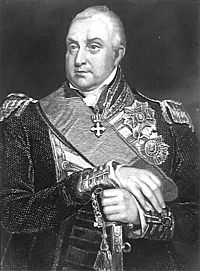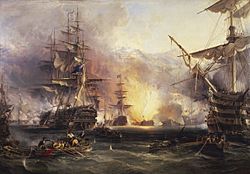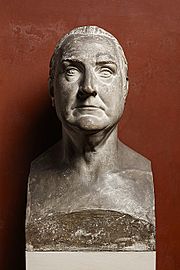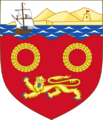Edward Pellew, 1st Viscount Exmouth facts for kids
Quick facts for kids
The Viscount Exmouth
|
|
|---|---|

Edward Pellew, 1st Viscount Exmouth, portrait by James Northcote, 1804
|
|
| Born | 19 April 1757 Dover, England |
| Died | 23 January 1833 (aged 75) Teignmouth, Devon, England |
| Allegiance | |
| Service/ |
|
| Years of service | 1770–1820 |
| Rank | Admiral |
| Commands held | Commander-in-Chief, East Indies Mediterranean Fleet Commander-in-Chief, Plymouth |
| Battles/wars | American War of Independence French Revolutionary Wars Napoleonic Wars Second Barbary War |
| Awards | Knight Grand Cross of the Order of the Bath |
| Relations | Israel Pellew (brother) |
Sir Edward Pellew, 1st Viscount Exmouth (born April 19, 1757 – died January 23, 1833) was a famous British naval officer. He fought in several major wars, including the American War of Independence, the French Revolutionary Wars, and the Napoleonic Wars. His younger brother, Israel Pellew, also had a career in the navy. Edward Pellew was known for his bravery and skill at sea, rising to the rank of Admiral.
Contents
Growing Up in Cornwall
Edward Pellew was born in Dover, England. He was the second son of Samuel Pellew, who commanded a small passenger and cargo ship called a packet boat. His family came from Cornwall, a county in southwest England.
After his father died in 1764, Edward's family moved to Penzance. Edward went to Truro Grammar School for a few years. He was known for being a bit rebellious and tough. At 14, he ran away to sea to join the navy.
In 1770, Pellew officially joined the Royal Navy on a ship called HMS Juno. He sailed to the Falkland Islands. Later, he served on HMS Alarm in the Mediterranean Sea for three years.
He had a disagreement with his captain and was left ashore in France. However, he managed to get a ride home to England.
Fighting in America and Beyond
American War of Independence
In 1776, Pellew served on HMS Blonde, which took General John Burgoyne to America. He was later sent to serve on a smaller boat called the Carleton on Lake Champlain. During the Battle of Valcour Island in October 1776, his commanders were badly hurt. Edward Pellew, though still young, took command and bravely saved the ship from danger. For this, he was given command of the Carleton.
In 1777, Pellew and some sailors joined the army under General Burgoyne. He fought in the Battle of Saratoga, where his youngest brother, John, was killed. Edward and his group were captured but later sent back to England.
Promotions and New Commands
Back in England, Pellew was promoted to lieutenant in 1778. He wanted to serve on a ship at sea. He eventually joined the Apollo in 1779. On June 15, 1780, the Apollo fought a large French privateer (a privately owned warship) called the Stanislaus. His captain was killed, but Pellew continued the fight. He damaged the French ship so much that it ran aground. For his brave actions, he was promoted again to command a small warship called the Hazard.
In 1782, Pellew commanded a small French ship he had captured, called HMS Pelican. He once again showed his bravery by fighting and driving three French privateers ashore. As a special reward, he was promoted to post-captain. This was a very important rank in the navy.
Life Between Wars
From 1786 to 1789, Pellew commanded the frigate HMS Winchelsea. He then commanded the Salisbury. In 1791, he took a break from the navy and tried farming, but it wasn't very successful. He even turned down an offer to join the Russian navy.
However, when France declared war on Great Britain in 1793, Pellew immediately asked for a ship.
Hero of the French Revolutionary War
First Frigate Capture
Pellew was given command of HMS Nymphe, a 36-gun frigate. He quickly got the ship ready for sea. He even recruited about 80 Cornish miners to help make up his crew.
On June 18, 1793, the Nymphe met the French frigate Cléopâtre. After a fierce battle, the Cléopâtre's mast and steering wheel were destroyed. Pellew's crew boarded the French ship and captured it. The French captain was badly wounded and died trying to destroy his secret signal codes. These codes fell into Pellew's hands, which was very valuable for the British navy. This was the first French frigate captured in the war. For this victory, King George III knighted Edward Pellew.
More Victories at Sea
Pellew then moved to HMS Arethusa. In 1794, his squadron (a group of warships) fought a French squadron. The British force was stronger and quickly won. Arethusa played a key role in capturing the Pomone, which was the largest frigate at the time.
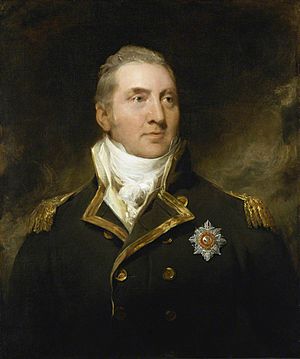
By 1794, Pellew was a commodore, leading the Western Frigate Squadron. In 1795, he took command of HMS Indefatigable, a ship he became very famous for.
Saving Lives and a Baronetcy
Pellew was an excellent swimmer and known for saving sailors who fell overboard. His most famous rescue happened on January 26, 1796. A large ship called the Dutton, carrying over 400 troops, women, and children, ran aground near Plymouth Hoe in a storm. The people on board couldn't get to shore. Pellew bravely swam out to the wreck with a rope. With help, he set up a lifeline that saved almost everyone on board. For this incredible act, he was made a baronet, a special honor from the King.
In 1796, his squadron captured two more French frigates, the Unité and the Virginie.
The Battle with Droits de l'Homme
Pellew's most famous battle was on January 13, 1797. While cruising with HMS Amazon, the British ships spotted a large French warship called the Droits de l'Homme. This French ship was a "ship of the line," much bigger and more powerful than Pellew's two frigates. However, HMS Indefatigable was a "razée," meaning it was originally a larger ship that had been cut down to be faster.
In stormy weather, Pellew used his excellent sailing skills to avoid the French ship's powerful guns. The battle lasted for many hours. In the early morning of January 14, all three ships were trapped near a dangerous coastline. Both the Droits de l'Homme and Amazon ran aground, but Pellew skillfully managed to sail the Indefatigable to safety.
Admiral and Viscount
Pellew was promoted to rear admiral in 1804. He was then made Commander-in-Chief, East Indies, a very important position overseeing British naval forces in the East. He arrived in 1805.
In 1808, he heard that war had broken out between Britain and Denmark. He quickly sailed to the Danish settlement of Tranquebar and captured it by surprise. This action earned him a lot of prize money.
After returning from the East in 1809, he held other important commands, including Commander-in-Chief, North Sea and Commander-in-Chief, Mediterranean.
In 1814, he was given the title of Baron Exmouth. In 1816, he led a combined British and Dutch fleet against the Barbary states in North Africa. These states were known for capturing ships and enslaving their crews. His fleet attacked the city of Algiers in what is known as the Bombardment of Algiers. This victory led to the release of 1,200 Christian slaves held in the city. For this great achievement, he was made the 1st Viscount Exmouth in December 1816.
After this, he became Commander-in-Chief, Plymouth from 1817 to 1821, before retiring from active service. He continued to speak in the House of Lords, the upper house of the British Parliament. He received many honors from different countries for his service.
Edward Pellew bought Bitton House in Teignmouth in 1812 and lived there until his death in 1833. He was buried in Christow.
Family Life
On May 28, 1783, Edward Pellew married Susan Frowde. They had four sons and two daughters:
- Emma Mary Pellew (1785–1835)
- Pownoll Pellew, who became the 2nd Viscount Exmouth (1786–1833)
- Julia Pellew (1787–1831)
- Fleetwood Broughton Reynolds Pellew, who also became an admiral (1789–1861)
- George Pellew, a church leader (1793–1866)
- Edward William Pellew, a minister (1799–1869)
Places Named After Him
Several places around the world are named after Edward Pellew:
- The Sir Edward Pellew Group of Islands in Australia's Gulf of Carpentaria were named by explorer Matthew Flinders in 1802.
- Cape Pellew in Australia is also named after him.
- Exmouth Gulf in Australia is named after his title, Viscount Exmouth.
- Point Pellew in Alaska was named by Captain George Vancouver in 1794.
The Palau islands (formerly called the Pellew or Pelew Islands) are sometimes thought to be named after him. However, they were named in 1783, before Edward Pellew became famous. Their name likely comes from the local word "Belau."
There are also buildings and units named after him:
- A building at HMS Raleigh, a naval training base, is used for new recruits.
- A Sea Cadet Unit in Truro is called T.S. Pellew.
- A building at Wyvern Barracks in Exeter, Devon, is named Pellew House.
Pellew in Fiction
Edward Pellew appears as a character in several fictional books and TV shows:
- He is featured as the Captain of HMS Indefatigable in some of C. S. Forester's Horatio Hornblower novels. In the TV adaptations, he is played by Robert Lindsay.
- He appears as a midshipman in the novel Jack Absolute by Chris Humphreys.
- Pellew is a minor character in some of Patrick O'Brian's Aubrey–Maturin novels.
- He has a small role in Rabble in Arms, a historical novel by Kenneth Roberts.
- He appears in Alexander Kent's Adam Bolitho novel Relentless Pursuit.
- He also appears in the Thomas Kydd novel, To The Eastern Seas by Julian Stockwin.
Images for kids


